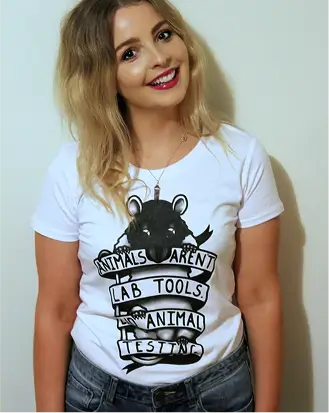Animals Are Unreliable Models
One of the biggest problems with animal experimentation is that animals are unreliable models for trying to predict outcomes in humans.
Animals are unreliable models because:
1. There are crucial differences between species
The obvious problem is that mice, rats, and other animals are not tiny humans. There are fundamental differences between species, so how could they ever reliably predict medical outcomes for one another? Imagine going to a vet (instead of a doctor) when you are sick – it just doesn’t make sense!
Examples:
Our hearts differ in many crucial ways, from the normal to maximal beats per minute, calcium sensitivity, responses to stress, and cell communication up to anatomical differences.1
- Dogs, pigs and sheep have more veins leading into the heart than humans and differ in the number and position of the valves.2
Our brains are obviously different in many anatomical ways, but even nonhuman primates are not suitable models for research into human stroke.3
- Immune responses to stroke are different in rodents and humans,4 and some even differ between mouse breeding lines.5
- So far, treatments aimed at “fixing” mice and rats mostly failed in humans.6
Only primates (including humans) possess a macula in their eyes.7 Macular degeneration is a major cause of vision impairment in elderly humans. However, healthy, young mice are by far the most used model subjects.8
Wound-healing models use mice, rats and pigs, but
- Rat and mouse skin is thinner and looser than ours, fur-coated with barely any sweat glands, and the healing follows a different process. We also react differently to burns.9,10
- Pigs and humans differ in the skin’s elasticity, hair coarseness and sweat gland characteristics.11 Pigs also do not form blisters in the same way as us.12
Chemicals can cause cancer in one species and not the other.13
- Laboratory animals do not get skin cancer from arsenic, which humans do.14
- The lethal dose of arsenic to animals ranges around 10 to 500-fold the dose that would kill a human.15
Animal models for Type 2 Diabetes ignore the vast differences in metabolising sugar between rodents and humans.16
- Insulin is encoded in different genes, their glucose transporters have different properties, the cell’s signalling for insulin works differently, the tissue where glucose is metabolised is different, the composition of the pancreas is different, and Type 2 Diabetes in humans progresses slowly, while the manipulated rodents get sick very fast.
Animal models of behavioural or mental disorders will never accurately copy the complexity of the disease.
- The most prominent Schizophrenia symptoms (hallucinations, delusions and ‘impaired speech’) cannot be measured in animal models.17
- Depression is a highly complex subjective disorder that cannot be “measured” in animal models.18
- The US National Institute of Mental Health discourages researchers from equating behaviours observed in animal “models” to human health conditions.19
2. What works in animals often does not work in humans
Animal tests (preclinical trials) are routinely conducted to try and prevent dangerous or ineffective new drugs from reaching human trials (clinical trials). However, there is a lot of robust scientific evidence proving that this isn’t working.
In fact, the use of animals to try and model human outcomes fails over 90% of the time: Learn more about this here.

Examples:
- Alzheimer’s Disease clinical trials have a failure rate of over 99%.20
- After decades of research and thousands of animal experiments on Multiple Sclerosis, there is still no actual cure in sight.21 There are medications to manage symptoms, but even the most advanced treatment (stem cell therapy, which is not yet approved in NZ, forcing Kiwi patients overseas) is only good for halting the disease progression.22
- Efforts to develop an HIV vaccine (requiring extensive animal testing) have so far failed. Many clinical trials had to be terminated due to safety concerns or lack of effectiveness.23 To this day, there are only options to prevent the virus from replicating, but no real cure.24
- Research into Type 2 diabetes has traditionally used animal models. Any glucose-lowering effects have so far, not translated to humans.25
- The possibility of success from animal models to the approval of a cancer drug in humans is calculated to be only 1.6%, or about 10.7% when using biomarkers.26
3. What is safe for animals can be dangerous for humans
Animal experiments failing to detect when compounds are toxic to humans have caused disasters in the past (and will likely cause more in the future). The examples below help highlight this risk.
- Macaque monkeys tolerate more than 10 times higher doses of paracetamol (acetaminophen) than would cause liver failure in humans.27
- A potential cancer drug (TGN1412) that tested safe in monkeys and rats caused the six human volunteers trying a much lower dose life-threatening complications.28
- Thiazolidinedione drugs (for diabetes) have caused liver disease,29 heart failure and stroke in humans30 while testing safe and effective in rodents.31
- Fialuridine (for Hepatitis B) seemed safe in mice, rats, monkeys, and dogs at high doses but caused severe liver failure in lower-dose human trial patients.32
- Vioxx (for arthritis) proved safe in tests on mice, rats, squirrels, rhesus monkeys, rabbits, and dogs.33 But between its approval and market withdrawal it caused at least 28,000 human deaths.34
- Between 1950 and 2014, there were 56 approved medications being withdrawn from the New Zealand market due to adverse reactions.35 Of these, 33 withdrawals were associated with patient deaths.
4. What doesn’t work in animals might save human lives.
Not only are our differences regularly causing new medicines to fail, but who knows how many life-saving drugs we abandoned, just because they did not work in animal tests?
Many people know that dogs and cats should not eat chocolate or avocado, nor have coffee, grapes, raisins, onion, garlic, avocado, alcohol, nuts, or xylitol (contained in chewing gum)36 while these are all enjoyable for humans.
- According to the Merck Veterinary Manual calculator, from eating a “regular” amount of chocolate, you would be in big trouble if you were a dog or a cat. Check it out here.
Other examples:
If you have a pet rodent, you might know that Penicillin is:
- fatal for guinea pigs and hamsters.37
- effective in mice.38
- neurotoxic for rabbits and can cause seizures.39
Yet it is one of the most commonly used and important antibiotics in human health.
How about over-the-counter pain medications?
- Aspirin is teratogenic in rats (causes birth defects or resorption of the foetuses).40
- Aspirin and Ibuprofen cause ulcers and renal damage in both cats and dogs and can be lethal.41
If you were lucky to survive a heart attack or stroke, you likely had Alteplase. It is an activator for specific enzymes that dissolve the fibres clotting the blood. The World Health Organisation included it in its list of Essential Medicines.42
- But had this drug been tested on pigs, it would not have advanced to human trials because in pigs this mechanism does not work.43
Kidney transplantation is not tolerated in dogs but it saves countless human lives.44
Medications that were approved and used for humans before studies showed that they caused cancer in lab animals include:
- Phenobarbital (anaesthetic) causes cancer in mice and rats.45
- Tamoxifen (breast cancer treatment) causes liver tumours in rats.46
- Isoniazid (tuberculosis treatment) causes cancer in mice, rats and rabbits.47
- Furosemide (diuretic) causes liver cancer in mice48 and damages the kidneys of rats and mice.49
- Metronidazole (antibiotic) causes cancer in rats50 and mice.51
Sad fact: we simply don’t know how many life-saving medications we have abandoned because they did not work on animals.
- https://doi.org/10.1016/j.pharmthera.2013.10.007
- https://doi.org/10.1016/j.jvc.2017.10.004
- https://doi.org/10.4103/1673-5374.274324
- https://doi.org/10.1177/0271678X16656199
- https://doi.org/10.1186/s40478-016-0371-y
- https://doi.org/10.3390/ijms23158367
- https://doi.org/10.1016/j.mam.2012.06.003
- https://doi.org/10.1167/iovs.63.9.11
- https://doi.org/10.1111/j.1067-1927.2004.12601.x
- https://doi.org/10.1155/2011/969618
- https://doi.org/10.1046/j.1524-475x.2001.00066.x
- https://doi.org/10.2741/3580
- https://www.ncbi.nlm.nih.gov/books/NBK570327/
- https://doi.org/10.1016/j.taap.2003.07.009
- https://wwwn.cdc.gov/TSP/ToxProfiles/ToxProfiles.aspx?id=22&tid=3
- https://doi.org/10.14573/altex.1309231
- https://doi.org/10.3389/fnint.2021.726321
- https://doi.org/10.1038/s41398-022-01790-8
- https://grants.nih.gov/grants/guide/notice-files/NOT-MH-19-053.html
- https://doi.org/10.18632/oncotarget.9175
- https://doi.org/10.1038/nature11102
- https://www.msnz.org.nz/ms-treatments/
- https://www.niaid.nih.gov/diseases-conditions/hiv-vaccine-research-history
- https://www.who.int/news-room/fact-sheets/detail/hiv-aids
- https://doi.org/10.1097/MOL.0000000000000599
- https://doi.org/10.1093/biostatistics/kxx069
- https://doi.org/10.3109/00498254.2014.973000
- http://doi.org/10.1056/NEJMoa063842
- https://hdl.handle.net/2268/12157
- https://doi.org/10.3399/bjgp09X453440
- https://www.accessdata.fda.gov/drugsatfda_docs/nda/99/20719S12_Prelay_prntlbl.pdf
- http://www.nap.edu/catalog/4887.html
- https://www.accessdata.fda.gov/drugsatfda_docs/nda/99/021042_52_Vioxx.cfm
- https://www.finance.senate.gov/hearings/fda-merck-and-vioxx-putting-patient-safety-firstd
- https://doi.org/10.1186/s12916-016-0553-2
- https://doi.org/10.2478/v10102-009-0012-4
- https://pubmed.ncbi.nlm.nih.gov/4446629
- https://doi.org/10.1016/S0140-6736(01)08728-1
- https://doi.org/10.1016/0014-4886(82)90001-2
- https://doi.org/10.1002/jez.1402160111
- https://doi.org/10.1016/j.cvsm.2012.01.003
- https://hdl.handle.net/10665/325773
- https://doi.org/10.1097/01.mbc.0000233374.79593.57
- https://doi.org/10.1172/JCI103085
- https://archive.org/details/humanepidemiolog0000unse/page/358/mode/2up
- https://aacrjournals.org/cancerres/article/53/17/3919/499203/Two-Year-Carcinogenicity-Study-of-Tamoxifen-in
- https://doi.org/10.1038/bjc.1966.65
- https://doi.org/10.1038/251508a0
- https://ntp.niehs.nih.gov/publications/reports/tr/300s/tr356/
- https://doi.org/10.1016/0002-9610(83)90168-X
- https://doi.org/10.1007/BF00404396





